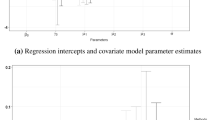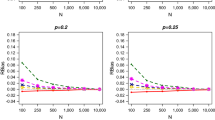Abstract
We present a Bayesian mark-recapture method for explicitly communicating uncertainty about the size of a closed population where capture probabilities vary across both individuals and sampling occasions. Heterogeneity is modeled hierarchically using a continuous logistic-Normal model to specify the capture probabilities for both individuals that are captured on at least one occasion and individuals that are never captured and so remain undetected. Inference about how many undetected individuals to include in the model is accomplished through a Bayesian model selection procedure using MCMC, applied to a product space of possible models for different numbers of undetected individuals. Setting the estimation problem in a fixed dimensional parameter space enables the model selection procedure to be performed using the freely available WinBUGS software. The outcome of inference is a full “posterior” probability distribution for the population size parameter. We demonstrate this method through an example involving real mark-recapture data.
Similar content being viewed by others
References
Agresti, A. (1994). “Simple Capture-Recapture Models Permitting Unequal Catchability and Variable Sampling Effort,” Biometrics, 50, 494–500.
Alho, J. M. (1990), “Logistic Regression in Capture-Recapture Models,” Biometrics, 46, 623–635.
Brooks, S. P. (1998). “Markov Chain Monte Carlo Method and its Application,” The Statistician, 47, 69–100.
Brooks, S. P., and Gelman, A. (1998), “General Methods for Monitoring Convergence of Iterative Simulations,” Journal of Computational and Graphical Statistics, 7, 434–455.
Buckland, S. T., Anderson, D. R., Burnham, K. P. and Laake, J. L. (1993), Distance Sampling, Estimating Abundance of Biological Populations, London: Chapman and Hall.
Buckland, S. T., Goudie, I. B. J., and Borchers, D. L. (2000), “Wildlife Population Assessment: Past Developments and Future Directions,” Biometrics, 56, 1–12.
Buckland, S. T., and Garthwaite, P. H. (1991), “Quantifying Precision of Mark-Recapture Estimates Using the Bootstrap and Related Methods,” Biometrics, 47, 255–268.
Burnham, K. P., and Overton, W. S. (1978), “Estimation of the Size of a Closed Population when Capture Probabilities Vary,” Biometrika, 65, 625–633.
Carlin, B. P., and Chib, S. (1995), “Bayesian Model Choice via Markov Chain Monte Carlo,” Journal of the Royal Statistical Society, Series B, 57, 473–484.
Carothers, A. D. (1973a), “Capture-Recapture Methods Applied to a Population With Known Parameters,” Journal of Animal Ecology, 42, 125–146.
— (1973b), “The Effects of Unequal Catchability on Jolly-Seber Estimates” Biometrics, 29, 79–100.
Casella, G., and George, E. I. (1992), “Explaining the Gibbs Sampler,” The American Statistician, 46, 167–174.
Chao, A., Lee, S. M., and Jeng, S. L. (1992), “Estimating Population Size for Capture-Recapture Data when Capture Probabilities Vary by Time and by Individual Animal,” Biometrics, 48, 201–216.
Cormack, R. M. (1989), “Log-Linear Models for Capture-Recapture,” Biometrics, 45, 395–413.
— (1992), “Interval Estimation for Mark-Recapture Studies of Closed Populations,” Biometrics, 48, 567–576.
Coull, B. A., and Agresti, A. (1999), “The Use of Mixed Logit Models to Reflect Heterogeneity in Capture-Recapture Studies,” 55, 294–301.
Darroch, J. N., Fienberg, S. E., Glonek, G. F. V., and Junker, B. W. (1993), “A Three-Sample Multiple-Recapture Approach to Census Population Estimation with Heterogeneous Catchability,” Journal of the American Statistical Association, 88, 1137–1148.
Dorazio, R. M., and Royle, A. J. (2003), “Mixture Models for Estimating the Size of a Closed Population When Capture Rates Vary Among Individuals,” Biometrics, 59, 351–364.
Ellison, A. M. (1996), “An Introduction to Bayesian Inference for Ecological Research and Environmental Decision-Making,” Ecological Applications, 6, 1036–1046.
Fienberg, S. E., Johnson, M. S., and Junker, B. W. (1999), “Classical Multilevel and Bayesian Approaches to Population Size Estimation Using Multiple Lists,” Journal of Royal Statistical Society, Series A, 162, 383–405.
Gelman, A., Carlin, J. B., Stern H. S., and Rubin, D. B. (1995), Bayesian Data Analysis, London: Chapman and Hall.
Gelman, A., Meng, X. L., and Stern, H. S. (1996), “Posterior Predictive Assessment of Model Fitness via Realized Discrepancies,” Statistica Sinica, 6, 733–807.
Gelman, A., and Rubin, D. B. (1992), “Inference From Iterative Simulation Using Multiple Sequences,”(with discussion), Statistical Science, 7, 457–511.
George, E. I., and Robert, C. P. (1992), “Capture-Recapture Estimation via Gibbs Sampling,” Biometrika, 79, 677–683.
Geweke, J. (1996), “Variable Selection and Model Comparison in Regression,” in Bayesian Statistics 5, eds. J. M. Bernado, J. O. Berger, A. P. Dawid, and A. F. M. Smith, New York: Oxford University Press, pp. 609–620.
Gilks, W. R., Thomas, A., and Spiegelhalter, D. J. (1994), “A Language and Program for Complex Bayesian Modeling,” The Statistician, 43, 169–177.
— (1996). Markov Chain Monte Carlo in Practice, London: Chapman and Hall.
Green, P. (1995), “Reversible Jump Markov Chain Monte Carlo Computation and Bayesian Model Determination,” Biometrika, 82, 711–732.
Huggins, R. M. (1989), “On the Statistical Analysis of Capture Experiments,” Biometrika, 76, 133–140.
Jeffreys, H. (1946), “An Invariant Form for the Prior Probability in Estimation Problems,” in Proceedings of the Royal Statistical Society, Series A, 186, pp. 453–461.
King, R., and Brooks, S. P. (2001), “On the Bayesian Analysis of Population Size,” Biometrika, 88, 317–336.
Kuo, L., and Mallick, B. (1998), “Variable Selection for Regression Models,” Sankhya, Ser. B, 60, 65–81.
Lee, S. M., and Chen, C. W. S. (1998), “Bayesian Inference on Population Size for Behavioural Response Models,” Statistica Sinica, 8, 1233–1248.
Lunn, D. J., Thomas, A., Best, N., and Spiegelhalter, D. (2000), “WinBUGS—A Bayesian Modeling Framework: Concepts, Structure, and Extensibility,” Statistics and Computing, 10, 325–337.
Norris, J. L., and Pollock, K. H. (1996), “Nonparametric MLE Under Two Closed Capture-Recapture Models With Heterogeneity,” Biometrics, 52, 639–649.
Otis, D. L., Burnham, K. P., White, G. C., and Anderson, D. R. (1978), “Statistical Inference From Capture Data on Closed Animal Populations,” Wildlife Monographs, 62, 1–135.
Pollock, K. H. (1991), “Modeling Capture, Recapture, and Removal Statistics for Estimation of Demographic Parameters for Fish and Wildlife Populations: Past, Present and Future,” Journal of the American Statistical Association, 86, 225–238.
Pollock, K. H., Nichols, J. D., Brownie, C., and Hines, J. E. (1990), “Statistical Inference for Capture-Recapture Experiments”, Wildlife Monographs, 107.
Pledger, S. (2000), “Unified Maximum Likelihood Estimates for Closed Capture-Recapture Models Using Mixtures,” Biometrics, 56, 434–442.
Rasch, G. (1960), Probabilsitic Models for Some Intelligence and Attainment Tests. Chicago: University of Chicago Press.
Schwarz, C. J., and Seber, G. A. F. (1999), “Estimating Animal Abundance, Review III,” Statistical Science 14, 427–456.
Seber, G. A. F. (1982), The Estimation of Animal Abundance and Related Parameters (2nd ed.), London: Charles Griffin and Company Ltd.
Smith, P. J. (1991), “Bayesian Analysis for a Multiple Capture-Recapture Model,” Biometrika, 78, 399–407.
Wade, P. R. (2000), “Bayesian Methods in Conservation Biology,” Conservation Biology, 14, 1308–1316.
Author information
Authors and Affiliations
Corresponding author
Rights and permissions
About this article
Cite this article
Durban, J.W., Elston, D.A. Mark-recapture with occasion and individual effects: Abundance estimation through Bayesian model selection in a fixed dimensional parameter space. JABES 10, 291–305 (2005). https://doi.org/10.1198/108571105X58630
Received:
Revised:
Issue Date:
DOI: https://doi.org/10.1198/108571105X58630




